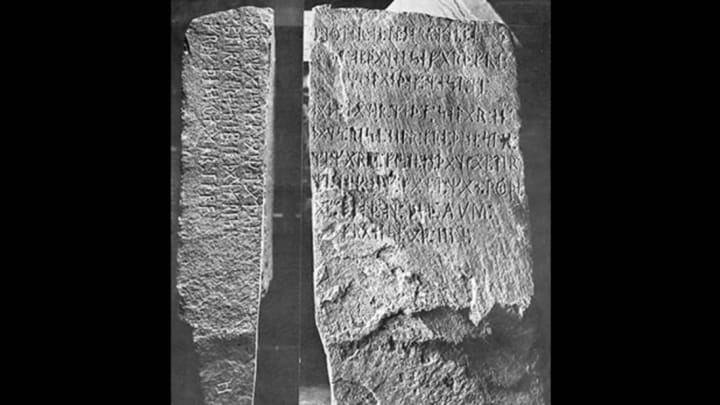If you want to learn about someplace, you can always pick up a textbook. But if you want to get to know a place, you're going to have to dig a little deeper. And what you find there might be a little strange.The Strange States series will take you on a virtual tour of America to uncover the unusual people, places, things, and events that make this country such a unique place to call home.
This week we’re heading to the land of gophers, lakes, and Vikings—the North Star State, Minnesota.
In 1898, Olof Olsson Ohman was clearing trees from his land in Alexandria, Minnesota when he came upon a 200-pound slab of sandstone in the roots of a stunted poplar tree. The stone, about 30 inches long, 16 inches wide, and 6 inches thick, had runes carved on it. Ohman took the slab to a Scandinavian-language newspaper in nearby Kensington, where the runes were translated. The inscription told of a Viking expedition dating back to the year 1362—well over one hundred years before Europeans set foot in North America.
Historians were obviously interested in the Kensington Runestone, especially Hjalmar Holand, an early advocate of the theory that Vikings had come to America long before Columbus. He purchased the stone for $10 and, over the next 40 years, traveled the world, taking the stone to dozens of experts in geology, linguistics, and anthropology to have it examined, hoping it could be verified as a genuine artifact. However, over 100 years since its discovery, the authenticity of the runestone is still up for debate. It seems for every expert who says it’s real, there’s another who claims it’s a hoax. The truth may never be fully revealed.
But for many people in Minnesota, there is no question—the Kensington Runestone is the real deal, no matter what the experts say. In fact, for Alexandria, where the stone was discovered, it has become a large part of the city’s identity. Not only is the actual runestone kept at the Runestone Museum, but there is a 25-foot tall granite replica of the stone marking the spot where Ohman found it. The replica, as well as a 28-foot tall Viking statue known as Big Ole, was hauled to New York in 1964 on a flatbed truck mocked up to look like a Viking longboat as part of an exhibit at the World’s Fair. Both have since returned home and are proudly displayed in Alexandria, which still claims to be the “Birthplace of America.”
Have the scoop on an unusual person, place or event in your state? Tell me about it on Twitter (@spacemonkeyx) and maybe I’ll include it in a future edition of Strange States!
See all the entries in our Strange States series here.
